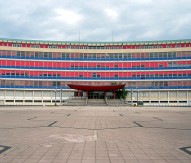

Accelerating technology
Dr Kenneth Österberg of the Helsinki Institute of Physics on the CLIC and MeChanICs projects that are building the next generation of particle accelerators.
The Large Hadron Collider (LHC) is the world’s largest and highest energy particle collider built by the European Organisation for Nuclear Research (CERN). It has been commissioned since 2009 and since early 2010 the LHC has held the record for the highest energy manmade particle collisions, currently at 8,000 billion electron volts (TeV).
In summer 2012, LHC reported the discovery of the Higgs boson, ending the decades-long search for the particle that completes the Standard Model of elementary particles. However, while the LHC is designed to reveal the existence of such particles, it cannot be used to make high precision studies of the properties of those particles required to understand the exact nature of the particle. This can only be performed by precision measurements of the particles properties at an electron-positron collider in the TeV range.
The Compact Linear Collider (CLIC) is one of the alternatives being studied that could fulfil the requirements for the future particle collider. It is for this reason that the Helsinki Institute of Physics (HIP) has conceived the Marie Curie linking Industry to CERN (MeChanICs) collaboration; a four-year project (2010-2014) that aims to enhance knowledge exchange in the field of high precision manufacturing.
The MeChanICs Industry-Academia Partnerships and Pathways (IAPP) platform for precision manufacturing knowledge exchange is a key part of Finland’s involvement in the CLIC R&D programme, gathering five manufacturing companies (Loval Oy, Metso Minerals Oy, Tarkmet Oy, Lewel Group Oy and Mectalent Oy) together to enhance their existing research and technology development efforts with Helsinki Institute of Physics (HIP) and CERN.
The mechanisms used for the transfer of knowledge within MeChanICs are two-way intersectoral secondments and dissemination workshops. Close co-operation with academia and industry in the near future is vital in devising an industrialisation scheme that enables the mass production of the required components at an affordable price and according to a stringent timeline. The scientific and technological objective of MeChanICs is to contribute at the early stage of the technical design phase of CLIC. Here, the main focus is to show technically how a multi-TeV CLIC can be built with the reasonable cost.
If built, CLIC will require a very large number of parts and components but as it is still in the development phase, the number of orders have been relatively low and focused mainly for experimental testing and quality assessments. CLIC is continuously searching for new companies that would be interested and capable, to participate in the development and manufacturing of the challenging components and structures.
It is here that MeChanICs steps into the breach, ensuring effective and sustainable future co-operation in the manufacturing of the collider components. The project provides the necessary networks and connections to overcome communication issues. The industry has the knowledge and experience of doing large scale productions to a much larger extent than research institutes, where the focus is on making working prototypes.
From a European industry perspective, CLIC represents major technological challenges, possibilities for long-term RTD collaboration, as well as significant future commercial opportunities, especially as CLIC technologies already show potential beyond particle physics applications.
The setup of MeChanICs has so far proved a valuable tool for the CLIC study, and is representative of the direction in which RTD is moving. New particle accelerator technology very often relies on cutting-edge technologies in materials, manufacturing, electronics and others, so there will be an increasing need for industry participation in R&D activities related to components for new accelerator technologies.

Dr Kenneth Österberg
Project Co-ordinator
Helsinki Institute of Physics
+358 919150512





